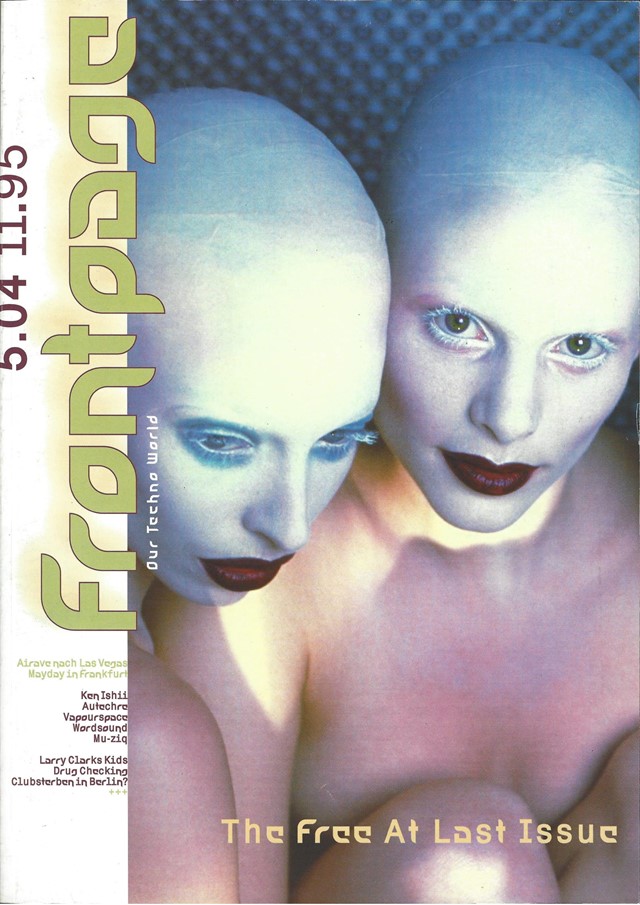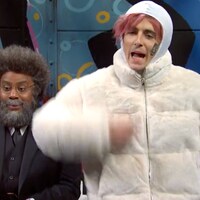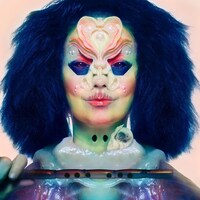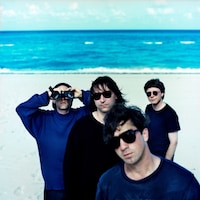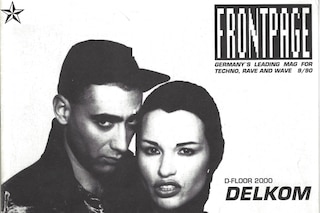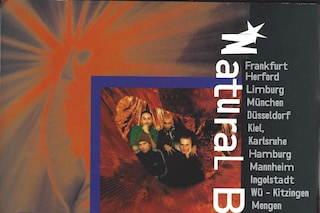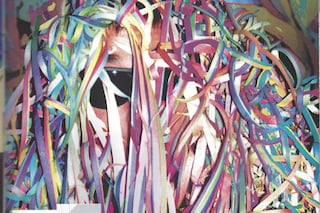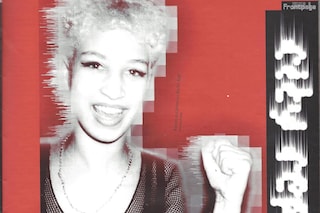With a guiding belief that techno was a way of life, the anarchic Frontpage magazine covered the country’s club scene with fun and flair
Few things paint a better portrait of 90s rave culture than German techno magazine Frontpage. Between its launch in 1989 and its final run in 1997, Frontpage was one of the leading voices of the country’s house and techno movement. As Stefan Weil, one of the magazine’s founding members, describes it, Frontpage was a “printed rave” and “graphic ecstacy”, chronicling the explosion of an entirely new subculture bound by a fixation on the music of the future.
Frontpage was first published in 1989 as the in-house fanzine for Technoclub, an influential party with an exclusively electronic soundtrack that used to take place at Disco Dorian Gray. a nightclub inspired by Studio 54 and located, unusually, in Frankfurt Airport. Alex Azary, Technoclub’s founder and a veteran of Frankfurt’s club scene, financed the early version of Frontpage as a local promotional tool, but its scope broadened over time. When Azary’s funding was exhausted, Frontpage contributor-turned-editor Jürgen Laarmann capitalised on the opportunity to move the magazine and its focus to what he viewed as a new, more progressive frontier – Berlin.
Frontpage was at the centre of a long held rivalry between Frankfurt and Berlin, with each city claiming techno for its own – despite varying definitions of the word. When Frontpage first launched, ‘techno’ in Germany referred to a Frankfurt sound whose backbone was formed by bands like DAF, Front 242, Neon Judgement, and The Klinik, but when Laarmann and other contributors relocated to West Berlin, they discovered an entirely new kind of techno subculture. Swapping established clubs and synth-punk bands for disused warehouses and acid house rhythms, the Frontpage editors found a scene that they felt was more forward-facing, where young East Germans would integrate into the West scene. “The impact of the GDR (East German) youth was massive on the movement. It was the sound of revolution… of liberation for them,” says Laarmann. “There was nowhere that German reunification worked better than in the techno scene. On the dancefloor, with smoke, strobes, and a Westbam soundtrack, you couldn’t tell who was East or West.”

Partying was the main occupation of Frontpage and its team of 24/7 rave reporters, who treated the magazine like “the newsroom for all forms of electronic music in the 90s”, as Weil puts it. They published stories about the emergence of new subgenres like trance and gabber, printed early stories on now-iconic artists like Joey Beltram, Westbam, Moby, and Aphex Twin, and mastered the ‘you heard it here first’ mentality with their extensive reviews of fresh releases. Serious music reviews were partnered with a very un-serious editorial voice characterised by an enthusiastic approach to self-destruction: Weil’s favourite columns were usually the craziest, with names like ‘Shopping on Speed’ and ‘Hardcore Decadence’. ‘Octopussies’, was a monthly column following a crew of female scenesters who Laarmann describes as “the Spice Girls before the Spice Girls”; the Octopussies were given a monthly editorial budget and encouraged to “attend parties, misbehave, and write about it”.
Underpinning the more outlandish ideas was the fundamental belief that techno was a way of life, not just a music genre. Beyond covering clubs, festivals, and raves, a Frontpage contributor’s job was to report on the “hot shit” in “wear and gear”, says Weil, and record stores, promoters, and club-wear labels became as much a part of the magazine as the articles themselves. The magazine was free for the taking, but only available in Frontpage-approved spots like the Tresor nightclub or Hard Wax Records.
“There was nowhere that German reunification worked better than in the techno scene. On the dancefloor, with smoke, strobes, and a Westbam soundtrack, you couldn’t tell who was East or West” – Jürgen Laarmann, Frontpage
Likewise, Frontpage’s aesthetic mirrored techno’s sonic innovation. In its early years, the magazine took inspiration from the DIY, cut’n’paste vibe of punk fanzines, but it soon honed a unique style of its own, with a maximalist layout and cutting edge art direction spearheaded by graphic designer Alexander Branczyk, whose over-the-top, ecstasy inspired designs virtually explode off the pages. “(Branczyk) translated the outstanding content and the attitude of the raving society into a very own graphic language,” says Weil. Frontpage was the first magazine in Germany to be created entirely on a Macintosh, and it shows: analogue photographs were manipulated, altered, and transformed, and every font during Branczyk’s five-year tenure as art director was a unique design.
“My inspiration was the dancefloor and the flickering lights in Berlin’s dirty clubs,” Branczyk says. “I wanted to make the design fucked up and messy.” Though Frontpage was a celebration of decadent partying, Branczyk’s time as art director was filled with more nights in than out. “I missed a lot of parties,” he says. “While the other guys were dancing, I was designing! I did it for myself and, usually, by myself.” According to Weil, “Branczyk was as important for electronic music, club culture, and rave as David Carson for indie, grunge, and post-rock.” The team’s obsession with new technology also led to Frontpage being one of the first ever magazines available online, under the the legendary domain techno.de.
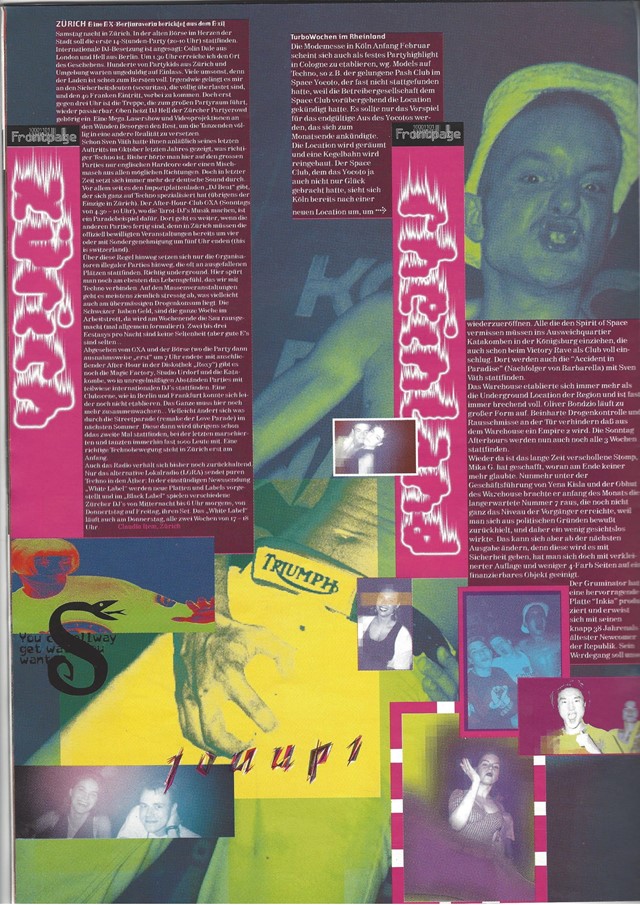
Laarmann describes his Frontpage era romantically. After all, he and the team made a living having fun, and they have years worth of magazines to show for it. Naturally, Frontpage was more than just a magazine. Writers and editors also organized a number of parties, events, and tours – most notably Mayday, the first major rave in Germany, and the Love Parade, a techno and drug-fuelled march through the streets of Berlin. The combination of events in 1991 caught the attention of the media and became known as the ‘German Summer of Love’. “Berlin was known as the place where a number of devastating events took place,” Laarmann explains. “Wars, Nazism, and Communism. The techno movement was the first time in a long time that Berlin, and really Germany, were recognised for something in a positive light and had international appeal.”
Frontpage came to a close in 1997, but 30 years later, many of its ideas have gone mainstream – Berlin is recognised as Europe’s rave capital, and Germany is a techno haven. At the same time, with AfD starting to gain power in Germany and right-wing, nationalistic sentiments rising internationally, Laarmann still believes there is work to be done in realising the magazine’s utopian vision. “Techno became a universal language with its own values, like tolerance, and denouncing sexism and racism,” he says. “You know, being there back then, it felt perfect. We really believed we had a bright future of inclusion and freedom ahead of us. We have to ask ourselves what went to wrong in between.”
